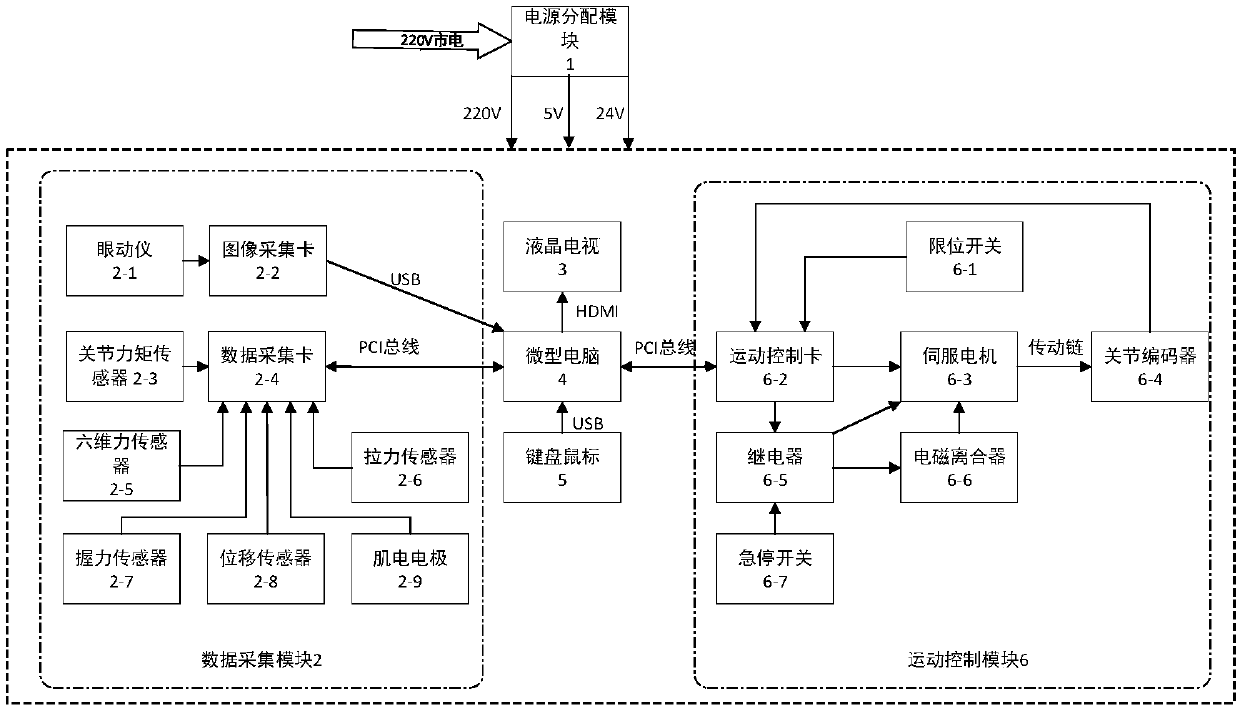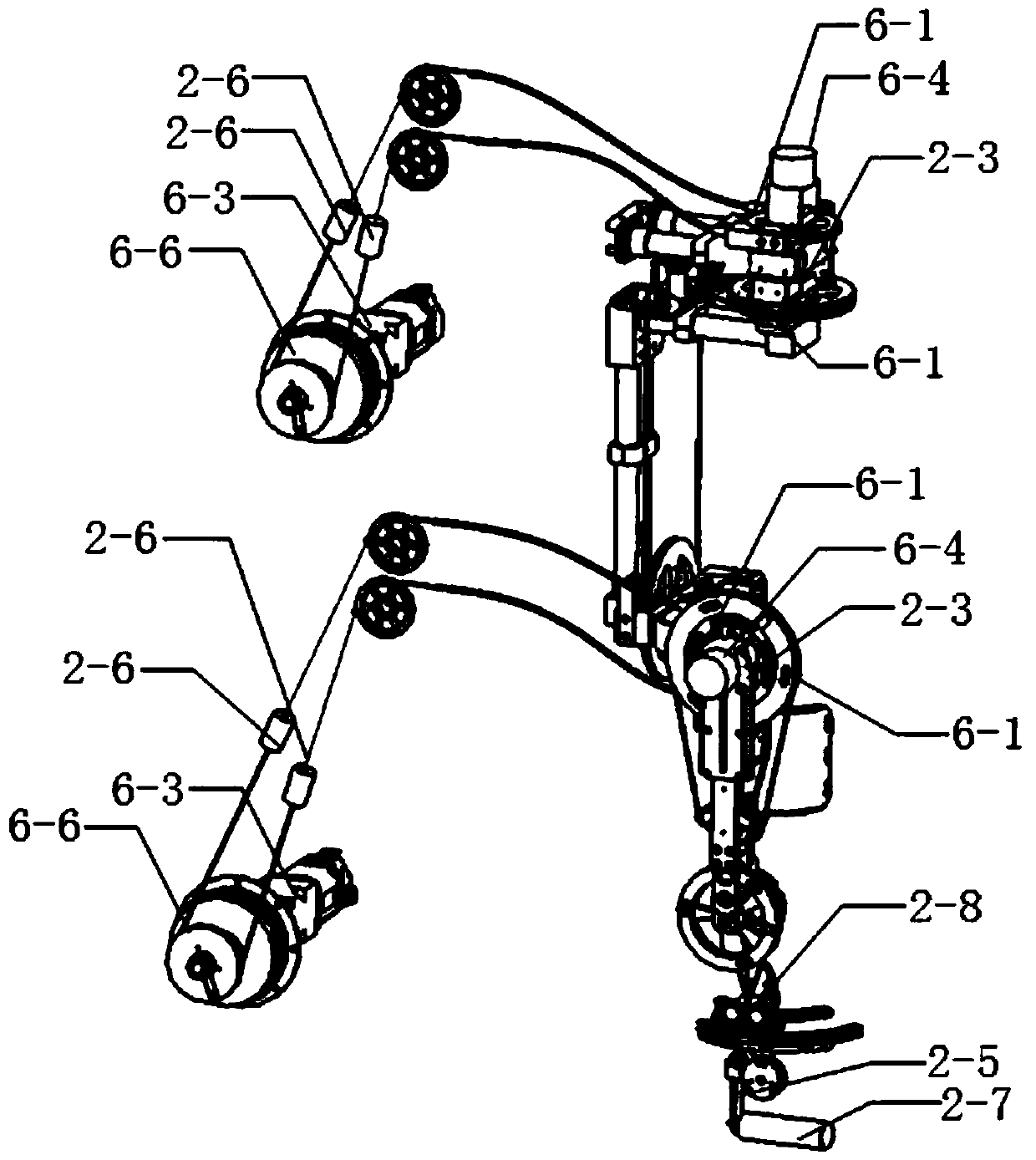An underactuated upper limb rehabilitation robot control system
A rehabilitation robot and control system technology, applied in general control systems, control/regulation systems, computer control, etc., can solve a single, only for patients in a specific rehabilitation period, can not effectively identify the patient's intention, patient autonomy and low participation, to achieve the effect of light and flexible actuators, rich types, and rich sensors
- Summary
- Abstract
- Description
- Claims
- Application Information
AI Technical Summary
Problems solved by technology
Method used
Image
Examples
Embodiment 1
[0031] The specific process when using passive mode for rehabilitation exercise is as follows:
[0032] The patient's arm is fixed on the mechanical arm of the rehabilitation robot through straps, and the palm is placed on the handle of the mechanical arm. The rehabilitation doctor selects the required rehabilitation training action through the keyboard and mouse 5 connected to the microcomputer 4 and modifies the corresponding parameters. The computer 4 sends the motion trajectory parameters corresponding to the rehabilitation action to the motion control card 6-2 through the PCI bus, and the digital output port of the motion control card 6-2 controls the relay 6-5 to close, and then the relay 6-5 makes the electromagnetic clutch 6-2 close. 6 and the servo motor 6-3 are powered on, and the motion control card 6-2 converts the motion command into an analog command that the servo drive 6-3 can recognize to control the motor movement. At this time, the servo motor 6-3 drives the ...
Embodiment 2
[0038] The specific process when using the eye movement model rehabilitation exercise is as follows:
[0039]The patient's arm is fixed on the mechanical arm of the rehabilitation robot through straps, and the palm is placed on the handle of the mechanical arm. The eye tracker 2-1 is worn by the patient, and the pupil position is monitored in real time through the miniature camera installed on the eye tracker. And send to microcomputer 4 by image acquisition card 2-2, calculate the required motion parameter of rehabilitation robot by the image algorithm in microcomputer 4 and send to motion control card 6-2 by PCI bus, motion control card 6-2 The digital output port of the control relay 6-5 is finely closed, and then the relay 6-5 enables the electromagnetic clutch 6-6 and the servo motor 6-3 to be powered on, and the motion control card 6-2 converts the motion command into the servo driver 6-3. The identified analog command controls the movement of the motor. At this time, th...
Embodiment 3
[0044] The specific process when using the active assist mode for rehabilitation exercise is as follows:
[0045] The patient's arm is fixed on the mechanical arm of the rehabilitation robot through a strap, and the palm is placed on the handle of the mechanical arm. The patient exerts a slight force on the handle. The direction of the force is the direction the patient wants to move. The six-dimensional force sensor 2-5 is The six-dimensional force information at the handle can be collected and sent to the microcomputer 4 through the data acquisition card 2-4. The microcomputer 4 calculates the motion parameters required by the rehabilitation robot through corresponding algorithms and sends them to the motion control card 6 through the PCI bus -2, the digital output port of the motion control card 6-2 controls the relay 6-5 to close, and then the relay 6-5 enables the electromagnetic clutch 6-6 and the servo motor 6-3 to be powered on, and the motion control card 6-2 will move...
PUM
 Login to View More
Login to View More Abstract
Description
Claims
Application Information
 Login to View More
Login to View More - R&D
- Intellectual Property
- Life Sciences
- Materials
- Tech Scout
- Unparalleled Data Quality
- Higher Quality Content
- 60% Fewer Hallucinations
Browse by: Latest US Patents, China's latest patents, Technical Efficacy Thesaurus, Application Domain, Technology Topic, Popular Technical Reports.
© 2025 PatSnap. All rights reserved.Legal|Privacy policy|Modern Slavery Act Transparency Statement|Sitemap|About US| Contact US: help@patsnap.com


